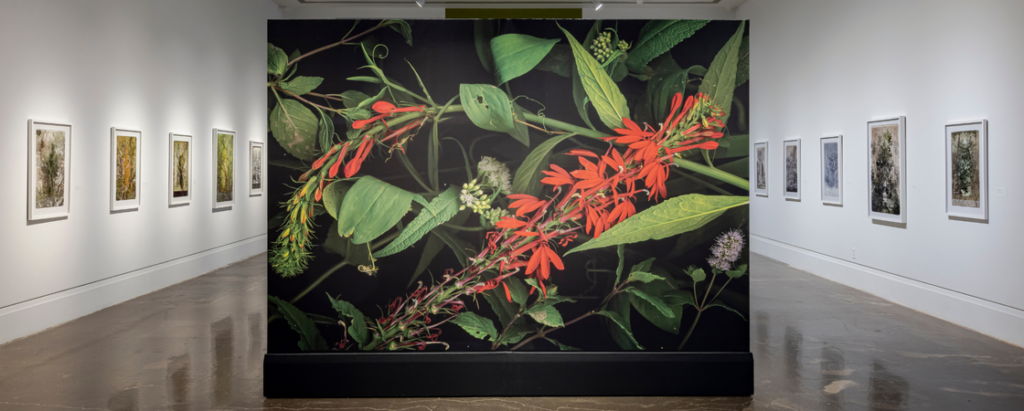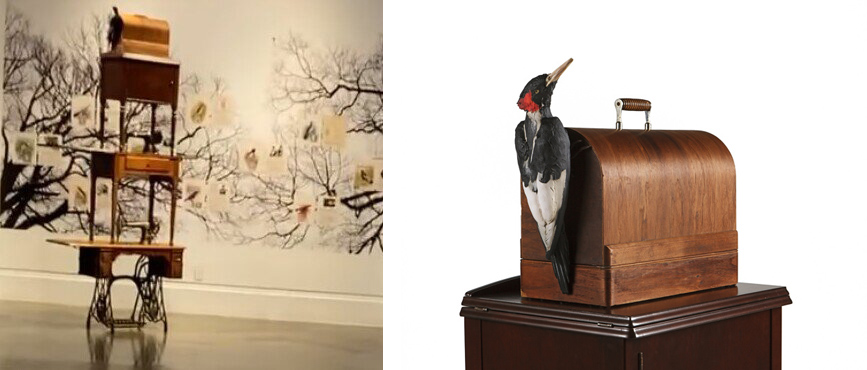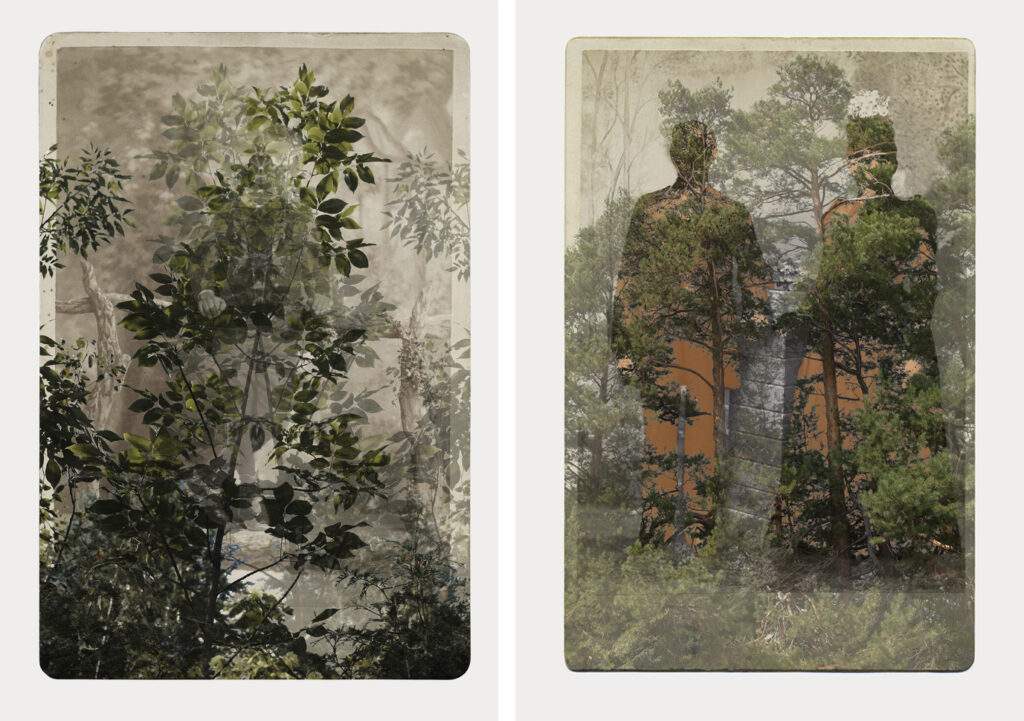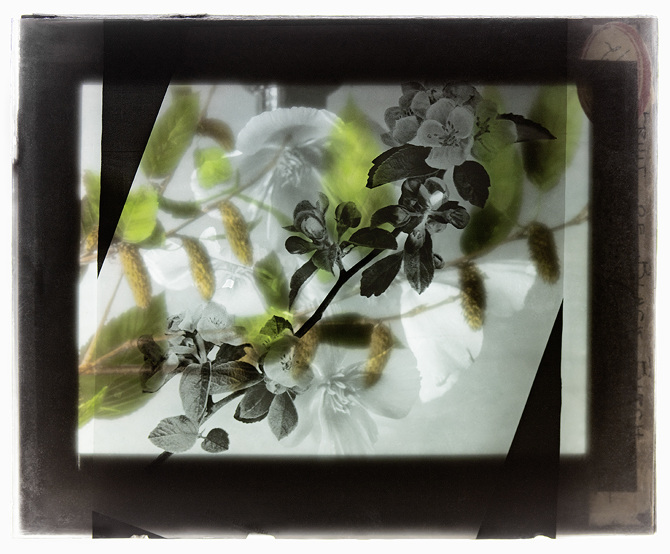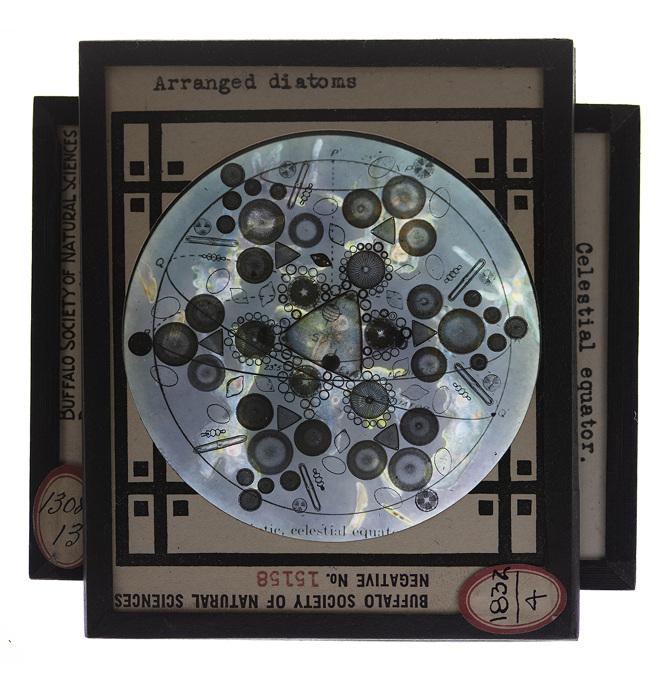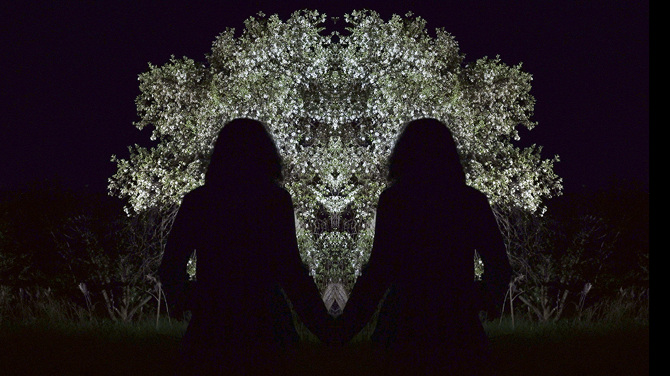Day and night represent different aspects for nature and humanity. Sara Angelucci’s work has captured this fascinating variety over the past ten years. She took already captivating imagery and turned it into something to question and consider. The show itself transports you into a world of mystery and intrigue. Her work transforms found photographs to create new images that explore cultural and historical facets outside those of the original image. It leads to morphing the picture and brings attention to the social standards that generated the language of photography. Angelucci’s works moved me from the traditional perspective of beauty and mystery; I found these unusual pieces beautiful on their own. The true meaning of these images, what they are derived from and what they aim to represent, is the real challenge of this show.
Installation view of Sara Angelucci, Undergrowth with August 15, 2022 Cardinal flower, Mint, Joe Pye Weed (centre) at AGM. Courtesy of AGM
The “Aviary” series (2013) is based on the idea of 19th century portrait photos. I found these compositions very intriguing and they also made me think about the artist’s intentions. The birds represented in these images are extinct. The artists merged them with anonymous nineteenth century cartes-de-visite portraits. Hunting and collecting unique things were in fashion at that time. People collected those birds; taxidermists preserved them so they could be presented as decoration or in scientific collections and now we recognize the power behind those human choices and how those decisions ultimately led to the loss of these impeccable species. The artist concluded in the Project Statement of Aviary, “what would it mean to embody another creature: Could one then see, feel, and understand its desire to live? Might we then imagine the Aviary portraits as chimera suspended in a state of empathy, and wonder what our treatment of other sentient beings might be if we could feel what they feel, or see what they see?”
L-R: Aviary (Heath Hen/extirpated), 2013, Aviary (Red-headed Woodpecker/endangered), 2013 and Aviary (Barn Owl/endangered), 2013, both C-print, 22 x 33.5 inches. Courtesy of the artist.
The artist’s love of birds is evident in this masterpiece of mockery, titled “Sightings” (2015). It depicts the Ivory-billed Woodpecker and pinpoints how the Singer Sewing machine and its creation were the reason they no longer grace us with their presence. The wall behind this installation is covered with replicas of vintage cards that depict native American songbirds. The piece is finely crafted and encourages awareness of situations such as the creation of the Singer sewing machines with its need for wood, which led to the collapse of the Ivory-billed Woodpecker’s habitat and led to its untimely extinction. It opens us up the idea that even cutting down a single tree can lead to the eradication of a whole community, and further addresses the issue that humans keep deepening the divide between themselves and nature.
Installation view with Sightings (left, photo: Cassandra Johnson) and Sightings (Ivorybilled Woodpecker), 2015, 4 wooden Singer sewing machine cabinets, 3D printed bird – 11″ tall, sculpture 9.5′ detail (right, courtesy of the artist)
The series of “Arboretum” (2016), “Black Flowers” (2021), and “The Twirl of a Butterfly’s Tongue” (2022) further focuses on colonial influences. The “Arboretum” series are Victorian-era cabinet card portraits with painted forest backdrops. Originally the concept was to portray humans using the forest as a backdrop, but in Angelucci’s photographs the people have become the backdrop. I find this idea very enticing and it gives me a feeling of harmony.
Arboretum (Boy/Double Ash) & Arboretum (Man/Woman/Pines), both Inkjet print, 2016. Courtesy of the artist.
The “Black Flowers” series uses compositions made with a discarded science collection of early 20th century glass lanterns from the Buffalo Society of Natural Sciences. It was once an educational tool and now represents Victorian mourning bouquets. The long-standing tradition of gifting flowers during times of love and loss has continued to today; they represent thoughts and feelings and offer a moment of bliss in good or bad situations.
Black Flowers (Milkweed), 2017, Inkjet print, 82.04 x 69.14 cm. Courtesy of the artist.
The “Twirl of a Butterfly’s Tongue” is a video that uses many more lantern slides. It targets our need for organization and to keep the world in order through categorization. It is a moment of influence and aims to spark the constant need to learn more about nature. Not only are these pieces beautiful but they also give new ideas and motivate us to look deeper into concepts we might not fully understand or even think about.
The Twirl of a Butterfly’s Tongue, 2022, video 5:03 min. Courtesy of the artist.
In “Nocturnal Botanical Ontario” (2019-on going), Angelucci depicts the plants surrounding her home and studio at Pretty River Valley. She tends to work mostly at night with a scanner that illuminates the environment around them. It puts focus on the plants and insects thriving under cover of darkness. The result of this evokes the acceptance of native and invasive wildlife residing in the world around us. This piece is double-sided and magically transports the viewer into the life of these plants, the shadows that surround them, and the air that cloaks them. These are powerful compositions and I can’t wait to see where this project will lead.
Installation view with October 14, Milkweed #1, (left, photo: Cassandra Johnson) on one side of the panel and August 15, 2022 Cardinal flower, Mint, Joe Pye Weed (Courtesy of AGM) on the other side of the panel.
“Ghost Orchard” (2022), holds great sentimental value to the artist as it represents her childhood, and an abandoned orchard from their old farm in Hamilton. From the farm only an old tree stands. The rest of the area is fenced up for construction. The video captures the moments before modern society and it’s need to demolish nature to further the economy. I admire Angelucci’s ability to create this narrative that speaks volumes without saying a word, to capture a personal longing and to protect memories while creating a ghost-like atmosphere.
Ghost Orchard, 2022, Video. 7:05 min. Courtesy of the artist.
Sara Angelucci has a talent for showing the reality of the divide between humans and nature. She makes the viewer contemplate our choices, such as how a decision to create a sewing machine was a fundamental cause in the extinction of a bird. I recommend attending this show as it was not only beautiful but educational and thought provoking as well. Also, the flyer you receive at the exhibition offers a special gift: it’s plantable — just plant it, water it, and watch it grow.
Cassandra Johnson
*Exhibition information: Sara Angelucci, Undergrowth, April 20 – July 7, 2024, Art Gallery of Mississauga, 300 City Centre Drive, Mississauga. Gallery hours: Tue, Wed & Fri: 10am – 5pm, Thu: 10am – 8pm, Sat & Sun: 12pm – 4pm

